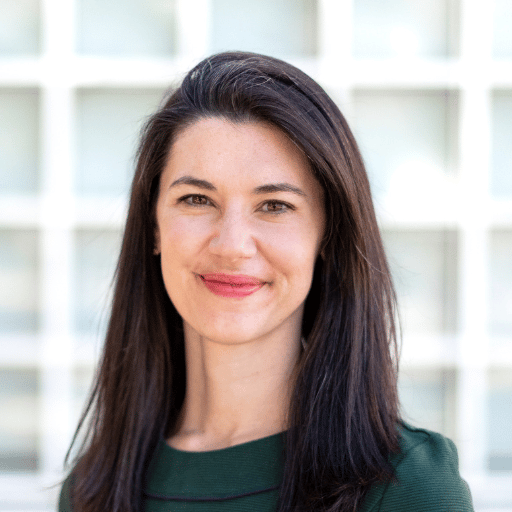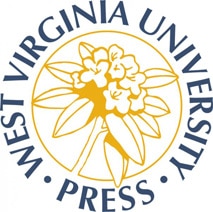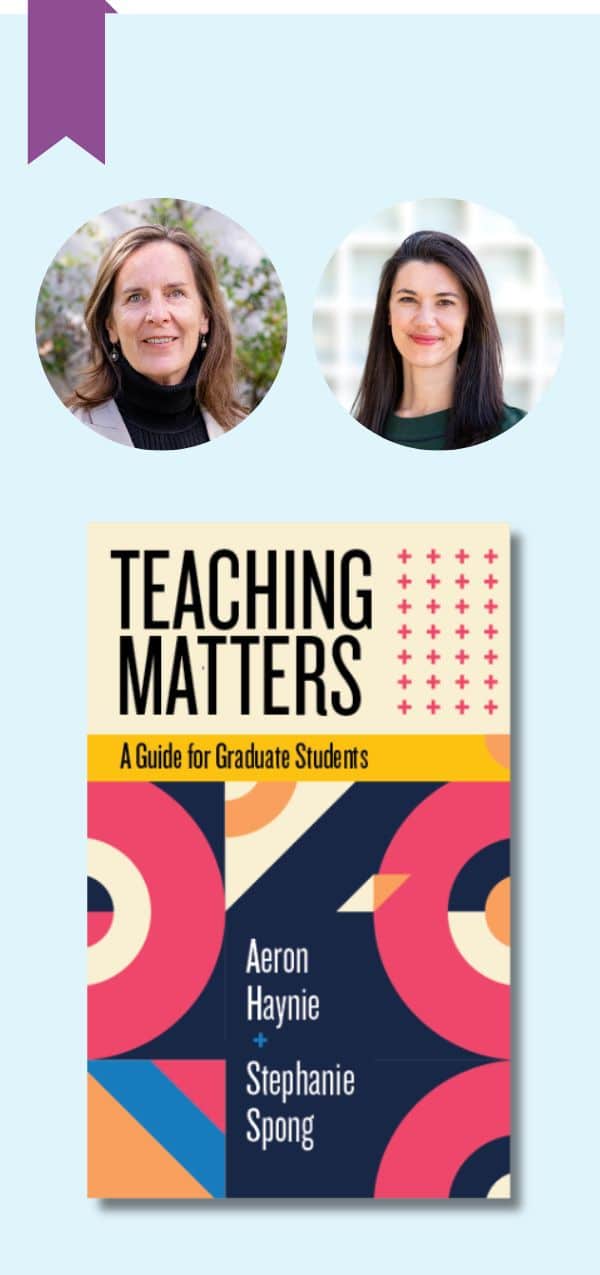‘Teaching Matters’: An Interview with Aeron Haynie and Stephanie Spong

Aeron Haynie

Stephanie Spong

James M. Lang

Many of us with advanced degrees had our first teaching experiences in graduate school. This meant that we were expected to educate others while we were still pursuing our own education. In my own graduate school experiences, I received a one-day teacher-training and was then thrown into my first classroom and expected to teach a full course on my own. Fortunately, graduate programs have now recognised that graduate-student educators need more support than that. But even as such programs become more robust, graduate students face a different set of challenges than new full-time instructors, as they balance their own studies with the needs of their students. Aeron Haynie and Stephanie Spong are experienced mentors of graduate-student teachers at New Mexico State University, and they brought their ideas and experiences to their book Teaching Matters: A Guide for Graduate Students. In this interview, I invited them to tell me about their inspiration for writing the book, the obstacles that graduate students face in the classroom, and how readers can learn more about their work.
James M. Lang, Ph.D.

Click here to view the video transcript
– Welcome, Aaron and Stephanie. We are here to talk about your recent book, “Teaching Matters: A Guide for Graduate Students.” And so I’m gonna ask you a few questions about it. This book emerged from the work you’ve done helping graduate student teachers and future professors. So what did you see as the sort of major challenges that you saw these academics and future academics struggling with?
– I’ll start and say that one of the reasons that we decided to write the book, that we are inspired to write the book, is that we felt that, first of all, a lot of graduate students, because their faculty are faculty at R1s, at graduate degree granting institutions, were really being told to de-emphasize teaching. So the number one reason we wanted to write it was first, as we talk about in our introduction, to really highlight why teaching matters, not just for the graduate students, and their probable future careers, but also for the undergraduates, the students that they’re serving. So that’s the meta answer. Stephanie, did you wanna add a more detailed answer?
– Yeah, sure. I think the other reason we were really inspired to write this book is because we met and talked to so many people where imposter syndrome or imposter phenomena was really evident and we met folks who felt like you kind of either got teaching or you didn’t, and we wanted to sort of pull back the curtain and make sure that graduate students really felt like, this was accessible for everyone.
– So you obviously observed students who were struggling, but you also probably saw graduate students who made a really good transition. So what were the kinds of strategies or attitudes that you saw in the students who did make that transition successfully into the teaching profession and then maybe you wanted to emphasize in the book?
– Yeah, I think first of all, one of the main things is that there are graduate students who were really good at forming community and finding community, sometimes within their department, among other graduate students in their discipline and other times across departments in our graduate resource center or in the courses that make up our teaching certificate. So that was one thing we wanted to highlight and encourage.
– I think we also saw graduate students do really well when they sort of thought of their teaching as an intellectual puzzle. They sort of didn’t see things, when things went wrong in the classroom they didn’t see it as like, ‘Oh, this is the student’s fault’, but instead sort of thought of it as like, ‘Okay, what can I do? What resources are available?’ and approached it with the same kind of research orientation that they did their actual research projects.
– So you wrote the book so graduate students, could make that transition more successfully. So tell me, gimme a sense of what a graduate student reader might find in the book and what kinds of like major topics or kinds of recommendations you offer there.
– Yeah, I think the book is written in a really practical way. So there are helpful strategies for sort of the first day, the first week, and then the arc of the semester. There are strategies in there about grading, about assignment creation, and then as Aaron mentioned earlier, about really creating community and the benefits of creating community, as not just a graduate student, but a graduate student who’s also teaching. And then there are also the voices of graduate students and their experiences, talking about both challenges and triumphs. And I think that can be really helpful to hear if you don’t feel like you’re getting that in your graduate program. Aaron, do you have others to add?
– Yeah, well I wanted to say that I’m really proud that we were able to get a diverse group of graduate students to share their stories. In one of our chapters, we have an international student and I think that’s sometimes often overlooked, not just the language differences, but the cultural differences between the American college classroom and other countries. So I thought that was important for us to sort of highlight what some of those struggles are. Graduate students who are given the course at the last minute, graduate students who don’t have a pedagogy practicum or seminar, so they’re sort of figuring it out on their own and graduate students, let’s say, who are teaching online for the first time. In addition to that, I also was really excited to include a chapter at the end, or an appendix at the end on how do you make this teaching experience work for you in the job interview? So that when you’re crafting the teaching statement, that would be substantial and interesting and really help you think through your teaching. And then also doing an on-campus interview, or what we think of as that teaching demo part of an on-campus interview that’s common in many job interviews.
– I think it’s a real achievement of the book that when you think about all the roles that graduate student teachers could play in a campus, it’s very wide, right? I mean, they could be teaching their own courses, being graders, being teaching assistants, but then as you’re pointing out now, also becoming like future professors and applying for jobs. So I think you all did a great job in kind of speaking to all those situations and finding the principles that really worked in those situations. You both work at a teaching center, as might some of your potential readers. So for the readers who are working in faculty development and maybe are working with graduate students or new faculty, how can they make the best use of the book?
– Yeah, one of the uses that we’re making of the book, our campus is making of the book, is in our teaching certificate for graduate students. We were lucky enough that our graduate studies, and our graduate deans, were really responsive in helping us create a certificate, really to serve primarily the students who don’t get that kind of rigorous training from their departments, or who want more and who wanna build that community. So one of the ways that the book is being used is that way, I think it could also be really fruitfully used with excerpts on particular topics in workshops, and then hopefully also in one-on-one consultations with graduate instructors. Stephanie, did you wanna say something about our recent conference or anything else?
– Oh, that’s it, yes. So our last teaching and learning conference this spring, we were fortunate enough to give copies out to the first 100 graduate students who registered. The conference is, we hold it annually, but this year we really wanted to highlight the amazing and talented graduate student instructors we have at UNM. So it was a way to both kind of incentivize folks to participate, but also to recognize and reward the really great teaching that graduate students are doing at UNM.
– So it sounds like you’re making good use of it on your campus, but are you available as resources for other campuses? Sounds like the book is, but also for both of you, do you travel to other campuses, give webinars for other campuses who might be looking for help with their graduate student teachers?
– Absolutely, both or either of us would be more than thrilled. We’ve already Zoomed in to some graduate classes most recently at Georgetown, to talk to those TAs who are reading the book. We’d be excited and available to do that, to talk to grad students about aspects of the book, to talk to teaching centers about the specific ways that we support graduate students and even in fact, if there are campuses that are thinking about designing certificates, teaching certificates for graduate students, we were involved in actually establishing that in that process and that’s something we’re knowledgeable about and interested in.
– All right, great, thank you for writing such a great book that would help many graduate students around the country. So very much appreciate it and best wishes to you both.
– Thank you.
Excerpt from the book
The first time Maria, a graduate student in anthropology, taught a class, the experience was so demoralizing that when it was over, she no longer wanted to be a professor. She had been assigned the introductory course three weeks before the beginning of the semester. The only advice from the department chair had been to look at another instructor’s syllabus. “No one talked to me about pedagogy, no one shared teaching or adult learning resources, and certainly no one taught me how to create a syllabus or structure the class toward specific learning outcomes.” Each Tuesday evening she faced a class of 30 sleepy and apathetic undergraduates:
“I felt like I was being tortured and, worse yet, that I was torturing these students. My limited perspective at the time, based entirely on my experience as a student, was that my job was to stand in front of the classroom, an irregularly shaped pentagon that reflected my awkwardness, and fill students with necessary information. And so I diligently prepared outlines for long lectures that were occasionally interspersed with class discussions and old anthropology films. Even in our occasional class discussions, it was less discussion and more students haphazardly responding to my questions and prompts. There were moments when silence filled the room and then one of the more attentive and forgiving students would offer a thought or question to break the stillness. Even now, I am grateful for those students, all three of them, who rescued me so often in those dull, uninspired lectures. The students and I slogged through learning the basics about how humans organize and make sense of the world around them. Our collective and unspoken goal was simply to get through the semester. I felt incapable of teaching and completely lost in the classroom. I was stuck believing that teaching was a talent one either possesses or lacks, and I fell in the latter category. As someone who was struggling unawares with impostor syndrome, I internalized what I considered my inability to teach until it damaged my sense of self. At the time, I thought if I cannot teach the basic principles of anthropology, I have no business as a faculty member. Coupled with a tremendous sense that my department was unsupportive and not designed for someone like me (first-generation, working-class woman of color), I decided that academia was not where I belonged. “
It was another two years before Maria began teaching again, but this time she had acquired new skills, honed other skills that had served her well, and was uplifted by both a supportive academic department and a professional setting that emphasized growth in teaching and learning. In each of these spaces, she started to feel that her experiences and background were assets in teaching and learning and that the practice of teaching was made visible as something that can be developed. Discussions about cultural aspects of learning, effective strategies in the classroom, and a higher purpose in teaching reflected back to her what she had always wanted higher education to be. “I realized I was not a terrible instructor after all. I just had never been taught how to teach.”
Teaching your first college class can be nerve-racking, even under the best of circumstances. After all, you’re not yet an expert in the field, you may not be much older than the undergraduates in front of you, and you’re juggling the new challenge of teaching along with the intense pressure of graduate studies. Although research universities are starting to take the teaching of undergraduates more seriously (Boyer, 1990; Patel, 2017), preparing and supporting graduate students’ teaching practice is still not a priority in many departments. For graduate students like Maria, who are thrown into the classroom with no training or mentorship, teaching can be a demoralizing experience. Even graduate students lucky enough to receive some classroom training rarely learn about new advances in learning science or how to teach inclusively. Not every graduate student has a teaching mentor or a space in which they feel comfortable discussing problems that arise in teaching. We have designed this book to fill in these gaps and to be a helpful guide for graduate students who are beginning their journeys as college teachers. We hope that it will be useful for those graduate students who do not receive pedagogical training from their departments, and even for those who wish to supplement their disciplinary teaching courses with a more general resource. We believe now more than ever that teaching matters: it matters to you and your future success as a professor, and it matters to the students you teach.
For discussion
If you taught while you were in graduate school, what were the major obstacles that you encountered in your first teaching experiences? If you could go back in time and offer some helpful advice to that new graduate teacher, what would you tell that person?
References
Click here to view the video transcript
– Welcome, Aaron and Stephanie. We are here to talk about your recent book, “Teaching Matters: A Guide for Graduate Students.” And so I’m gonna ask you a few questions about it. This book emerged from the work you’ve done helping graduate student teachers and future professors. So what did you see as the sort of major challenges that you saw these academics and future academics struggling with?
– I’ll start and say that one of the reasons that we decided to write the book, that we are inspired to write the book, is that we felt that, first of all, a lot of graduate students, because their faculty are faculty at R1s, at graduate degree granting institutions, were really being told to de-emphasize teaching. So the number one reason we wanted to write it was first, as we talk about in our introduction, to really highlight why teaching matters, not just for the graduate students, and their probable future careers, but also for the undergraduates, the students that they’re serving. So that’s the meta answer. Stephanie, did you wanna add a more detailed answer?
– Yeah, sure. I think the other reason we were really inspired to write this book is because we met and talked to so many people where imposter syndrome or imposter phenomena was really evident and we met folks who felt like you kind of either got teaching or you didn’t, and we wanted to sort of pull back the curtain and make sure that graduate students really felt like, this was accessible for everyone.
– So you obviously observed students who were struggling, but you also probably saw graduate students who made a really good transition. So what were the kinds of strategies or attitudes that you saw in the students who did make that transition successfully into the teaching profession and then maybe you wanted to emphasize in the book?
– Yeah, I think first of all, one of the main things is that there are graduate students who were really good at forming community and finding community, sometimes within their department, among other graduate students in their discipline and other times across departments in our graduate resource center or in the courses that make up our teaching certificate. So that was one thing we wanted to highlight and encourage.
– I think we also saw graduate students do really well when they sort of thought of their teaching as an intellectual puzzle. They sort of didn’t see things, when things went wrong in the classroom they didn’t see it as like, ‘Oh, this is the student’s fault’, but instead sort of thought of it as like, ‘Okay, what can I do? What resources are available?’ and approached it with the same kind of research orientation that they did their actual research projects.
– So you wrote the book so graduate students, could make that transition more successfully. So tell me, gimme a sense of what a graduate student reader might find in the book and what kinds of like major topics or kinds of recommendations you offer there.
– Yeah, I think the book is written in a really practical way. So there are helpful strategies for sort of the first day, the first week, and then the arc of the semester. There are strategies in there about grading, about assignment creation, and then as Aaron mentioned earlier, about really creating community and the benefits of creating community, as not just a graduate student, but a graduate student who’s also teaching. And then there are also the voices of graduate students and their experiences, talking about both challenges and triumphs. And I think that can be really helpful to hear if you don’t feel like you’re getting that in your graduate program. Aaron, do you have others to add?
– Yeah, well I wanted to say that I’m really proud that we were able to get a diverse group of graduate students to share their stories. In one of our chapters, we have an international student and I think that’s sometimes often overlooked, not just the language differences, but the cultural differences between the American college classroom and other countries. So I thought that was important for us to sort of highlight what some of those struggles are. Graduate students who are given the course at the last minute, graduate students who don’t have a pedagogy practicum or seminar, so they’re sort of figuring it out on their own and graduate students, let’s say, who are teaching online for the first time. In addition to that, I also was really excited to include a chapter at the end, or an appendix at the end on how do you make this teaching experience work for you in the job interview? So that when you’re crafting the teaching statement, that would be substantial and interesting and really help you think through your teaching. And then also doing an on-campus interview, or what we think of as that teaching demo part of an on-campus interview that’s common in many job interviews.
– I think it’s a real achievement of the book that when you think about all the roles that graduate student teachers could play in a campus, it’s very wide, right? I mean, they could be teaching their own courses, being graders, being teaching assistants, but then as you’re pointing out now, also becoming like future professors and applying for jobs. So I think you all did a great job in kind of speaking to all those situations and finding the principles that really worked in those situations. You both work at a teaching center, as might some of your potential readers. So for the readers who are working in faculty development and maybe are working with graduate students or new faculty, how can they make the best use of the book?
– Yeah, one of the uses that we’re making of the book, our campus is making of the book, is in our teaching certificate for graduate students. We were lucky enough that our graduate studies, and our graduate deans, were really responsive in helping us create a certificate, really to serve primarily the students who don’t get that kind of rigorous training from their departments, or who want more and who wanna build that community. So one of the ways that the book is being used is that way, I think it could also be really fruitfully used with excerpts on particular topics in workshops, and then hopefully also in one-on-one consultations with graduate instructors. Stephanie, did you wanna say something about our recent conference or anything else?
– Oh, that’s it, yes. So our last teaching and learning conference this spring, we were fortunate enough to give copies out to the first 100 graduate students who registered. The conference is, we hold it annually, but this year we really wanted to highlight the amazing and talented graduate student instructors we have at UNM. So it was a way to both kind of incentivize folks to participate, but also to recognize and reward the really great teaching that graduate students are doing at UNM.
– So it sounds like you’re making good use of it on your campus, but are you available as resources for other campuses? Sounds like the book is, but also for both of you, do you travel to other campuses, give webinars for other campuses who might be looking for help with their graduate student teachers?
– Absolutely, both or either of us would be more than thrilled. We’ve already Zoomed in to some graduate classes most recently at Georgetown, to talk to those TAs who are reading the book. We’d be excited and available to do that, to talk to grad students about aspects of the book, to talk to teaching centers about the specific ways that we support graduate students and even in fact, if there are campuses that are thinking about designing certificates, teaching certificates for graduate students, we were involved in actually establishing that in that process and that’s something we’re knowledgeable about and interested in.
– All right, great, thank you for writing such a great book that would help many graduate students around the country. So very much appreciate it and best wishes to you both.
– Thank you.


